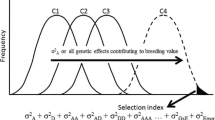Abstract
Understanding inbreeding in cassava can guide breeders to explore its effects. Therefore, the aim of this study was to evaluate the effects of inbreeding depression in cassava, as well as to select transgressive individuals. Five elite cassava varieties were self-pollinated (Cascuda, BRS Formosa, Fécula Branca, Mani-Branca, and BRS Mulatinha), and the S1 families were evaluated in an augmented block design with six repetitions. The traits evaluated were fresh root yield (RoYi), above ground yield (AGYi), starch yield (StYi), harvest index (HI), dry matter content (DMC), and plant height (PlHe). The inbreeding depression varied widely between families; it was high in BRS Formosa, with averages of 19.38 % (RoYi), 1.68 % (AGYi), 18.18 % (HI), 0.47 % (DMC), 17.54 % (StYi) and 3.5 % (PlHe). Except for the S1 family of BRS Formosa, the additive effects (μ + α) were the most important, ranging from 69.95 % (RoYi) to 98.20 % (AGYi). In contrast, the contribution of heterozygous loci (δ) was most relevant to RoYi, HI, and StYi, with averages of 30.05, 23.07, and 27.82 %, respectively, although these effects were more pronounced in S1 derived from BRS Formosa and Mani-Branca. Therefore, the exploitation of inbreeding effects in cassava can contribute to the selection of plants with better agronomic performance in order to obtain cassava inbred with high genetic and agronomic potential for use per se or as parents to produce new hybrids.
Similar content being viewed by others
References
Ahmad S, Khan MS, Swati MS, Shah GS, Khalil IH (2005) A study on heterosis and inbreeding depression in sunflower (Helianthus annuus L). Songklanakarin J Sci Technol 27:1–8
Arnhold E (2013) Package in the R environment for analysis of variance and complementary analyses. Braz J Vet Res Anim Sci 50:488–492
Aware SA, Deshmukh DT, Thakare SV, Zambre SM (2014) Heteosis and inbreeding depression studies in okra (Abelmoschus esculentus (L) Moench). Int J Curr Microbiol Appl Sci 3:733–747
Bison O, Aguiar AM, Rezende GDSP, Ramalho MAP (2004) Inbreeding depression in Eucalyptus clones. Crop Breed Appl Biotechnol 4:459–464
Calle F, Perez JC, Gaitán W, Morante N, Ceballos H, Llano G, Alvarez E (2005) Diallel inheritance of relevant traits in cassava (Manihot esculenta Crantz) adapted to acid-soil savannas. Euphytica 144:177–186
Ceballos H, Iglesias CA, Pérez JC, Dixon AGO (2004) Cassava breeding: opportunities and challenges. Plant Mol Biol 56:503–516
Ceballos H, Pérez V, Juan C, Iglesias F, Carlos A, Fregene M, Calle F, Jaramillo OG, Morante N, López J (2007) The use of doubled-haploids in cassava breeding. In: Howeler RH (ed) Cassava research and development in Asia: exploring new opportunities for an ancient crop. In: Proceedings of the seventh regional workshop held in Bangkok, Oct 28–Nov 1 2002. Centro Internacional de Agricultura Tropical (CIAT), Cassava Office for Asia, Bangkok, pp 150–160
Ceballos H, Sáchez T, Morante N, Fregente M, Dufour D, Smith AM, Denyer K, Pérez JC, Calle F, Mestres C (2007b) Discovery of amylose-free starch mutant in cassava (Manihot esculenta Crantz). J Agric Food Chem 55:7469–7476
Cleso APP, Santos MX, Cruz CD, Parentoni SN, Oliveira E, Guimarães HG, Gama EEG, Silva ÁE, Carvalho HWL, Júnior PAV (2002) Inbreeding depression of 28 maize elite open pollinated varieties. Genet Mol Biol 25:12–14
FAO (2014) FAOSTAT database. FAO, Rome. http://faostat.fao.org/. Accessed 26 Jan 2015
Fukuda WMG, Silva SO, Iglesias C (2002) Cassava breeding. Crop Breed Appl Biotechnol 2:617–638
Gardner CO (1965) Teoria de genética estadistica aplicable as las medias de variedades, sus cruces y poblaciones afines. Fitotecnica Latinoamericana 2:11–22
Hannah LC (2000) Starch biosynthesis and genetic potential. In: Murphy CF, Peterson DM (eds) Designing crops for added value. American Society of Agronomy, Madison, pp 181–199
Kawano K, Fukuda WMG, Cenpukdee U (1987) Genetic and environmental effects on dry matter content of cassava root. Crop Sci 27:69–74
Kawuki RS, Nuwamanya E, Labuschagne MT, Herselman L, Ferguson M (2011) Segregation of selected agronomic traits in six S1 cassava families. J Plant Breed Crop Sci 3:154–160
Keller LF, Waller DM (2002) Inbreeding effects in wild populations. Trends Ecol Evol 17:230–241
Oliveira EJ, Resende MDV, Santos VS, Ferreira CF, Oliveira GAF, Silva MS, Oliveira LA, Aguilar-Vildoso CI (2012) Genome-wide selection in cassava. Euphytica 187:263–276
Oliveira EJ, Santana FA, Oliveira LA, Santos VS (2014) Genetic parameters and prediction of genotypic values for root quality traits in cassava using REML/BLUP. Genet Mol Res 13:6683–6700
Prochnik S, Marri PR, Desany B, Rabinowicz PD, Kodira C, Mohiuddin M, Rodriguez F, Fauquet C, Tohme J, Harkins T, Rokhsar DS, Rounsley S (2012) The cassava genome: current progress, future directions. Trop Plant Biol 5:88–94
Rojas MC, Pérez JC, Ceballos H, Baena D, Morante N, Calle F (2009) Analysis of inbreeding depression in eight S1 cassava families. Crop Sci 49:543–548
Schons A, Streck NA, Storck L, Buriol GA, Junior Zanon A, Pinheiro DG, Kraulich B (2009) Arranjos de plantas de mandioca e milho em cultivo solteiro e consorciado: crescimento, desenvolvimento e produtividade. Bragantia 68:155–167
Sheela MN, Radhika VS, John KS, Abraham K (2008) Variation in crude protein, dry matter and starch in inbred and backcross lines of cassava. J Root Crops 34:115–119
Silva RM, Bandel G, Martins PS (2003) Mating system in an experimental garden composed of cassava (Manihot esculenta Crantz) ethnovarieties. Euphytica 134:127–135
Souza LS, Farias RN (2006) Aspectos socioeconômicos e agronômicos da mandioca. Embrapa Mandioca e Fruticultura Tropical. Cruz das Almas
Souza Sobrinho F, Ramalho MAP, Souza JC (2002) Alternatives for obtaining double cross maize hybrids. Rev Bras Milho Sorgo 1:70–76
Troyer AF (2006) Adaptedness and heterosis in corn and mule hybrids. Crop Sci 46:529–543
Yau C (2013) R tutorial with Bayesian statistics using OpenBUGS. Amazon Digital Services, Inc. 554
Acknowledgments
The authors thank the Fapesb, CAPES and CNPq for the financial assistance and scholarship support.
Author information
Authors and Affiliations
Corresponding author
Rights and permissions
About this article
Cite this article
de Freitas, J.P.X., da Silva Santos, V. & de Oliveira, E.J. Inbreeding depression in cassava for productive traits. Euphytica 209, 137–145 (2016). https://doi.org/10.1007/s10681-016-1649-7
Received:
Accepted:
Published:
Issue Date:
DOI: https://doi.org/10.1007/s10681-016-1649-7




